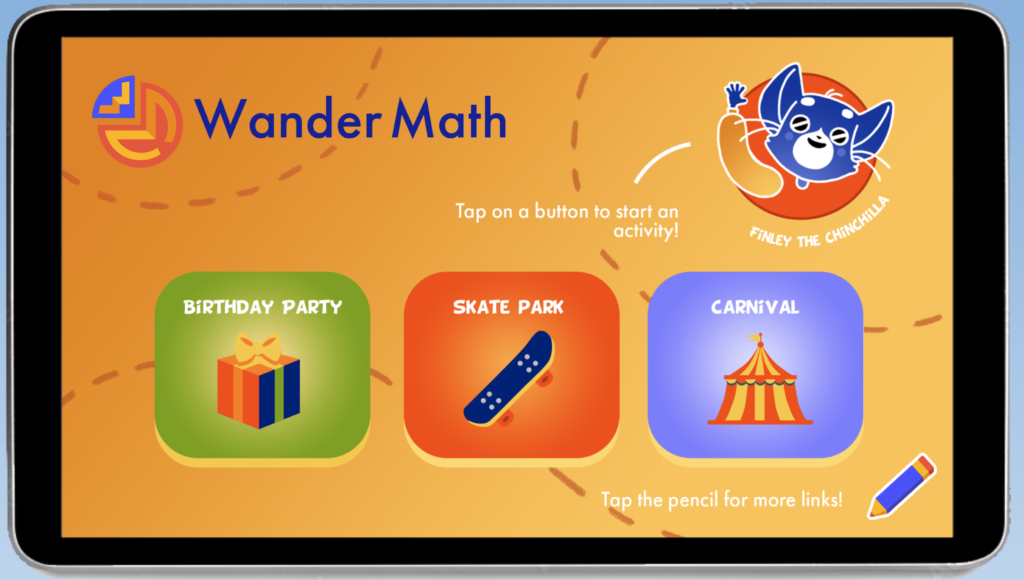Feel free to watch the promotion video to understand more about it.
WanderMath is a team project partnering with the Center for Arts and Education at West Liberty University to create an Augmented Reality (AR) experience inspired by Math Walks, to help 4th and 5th graders engage in open-ended math adventures.
WanderMath aims to not only help students “see math” but also engage them in playing with math, in pursuit of a critical and conceptual math understanding.
General info
This is a semester (14 weeks) long project during my Master’s degree at Carnegie Mellon University (CMU). Math Walks was created during the COVID-19 pandemic by a teacher interested in public math problems. By drawing math questions on the sidewalks, anyone can still be exposed to math in the public. This makes math less stressful with no scoring while letting them interact with math.
In order to create such an experience in the classroom setting, we have decided to make a virtual math walk experience through the help of AR technology. This allows our targeted users, 4th and 5th graders to enjoy the process of learning math while interacting with it freely. On top of that, we have also created a unique chinchilla character to allow the students to stay engaged throughout the experience.
We looked through all the Math Walk related questions and tweaked them to create 3 separate mini math experiences for the students, namely, a birthday party, a skate park and a carnival. Along with each experience created, we have also collaborated with other teachers to prepare a teacher resource guide on each topic. Ultimately, WanderMath is a 20-30 minutes math experience for students to interact with math in AR with the teacher reinforcing the concepts afterwards.
Introduction to the game

When the player opens the mobile application, they will be presented a home screen of 3 different activities.
Activities of the game

Each activity involves the player interacting with different things in real life to discover the math concepts. In the birthday party, the player has to rotate flat cubs, hexagons, centroids and etc shapes into an actual 3D shape. In the skate park, the player has to connect dots to form rectangles to learn about the concept of area, and then they have to drag it up and down to a specified volume. The drawn object will then be concretized for the character interactions. Lastly, in the carnival, the player has to shoot the correct targets based on a coordinate grid in order to gather prizes.
Although the chinchilla character, Finley, appears in all 3 activities, we implemented different animations and response for Finley. Finley will jump in excitement for the birthday parties, skate around in the skate park and get wet in the carnival according to different actions taken by the player.
The videos below shows a short run through of each activity to present a clearer view of the entire experience.
Technology used for the project
This game is created using Unity for the front end web gameplay, C# for the backend scripts. As it is an AR game, we also used Unity’s ARCore libraries to aid us throughout the development process.
My contribution to the project
I was the lead programmer of on team together with another programmer.
As the lead programmer, I was leading the development work while allocating tasks among ourselves to ensure that we are able to finish them on time. On top of the usual development of every activity, I also worked on incorporating interesting ARCore libraries such as anchors, plane tracking, point clouds to make the game smoother and more accurate throughout the gameplay.
Learnings and dicussions
As this is the first AR game we ever created, it was filled with major and minor challenges. The first major challenge is allowing users to interact with 3D AR technology using a 2D phone screen. We came up with multiple approaches in order to achieve this to be intuitive with minimal instructions provided. Another major challenge is the drafting of AR objects in the 3D space. This made the drawing of rectangles in the skateboard activity inaccurate. With multiple enhancements to reduce the draft issue, we also saved the locations of each dot locally in order to form the rectangle when they are drawn.
All in all, we have created a combined post-mortem document of the project here. Feel free to check it out to learn more details about the challenges faced and how we solved them.
